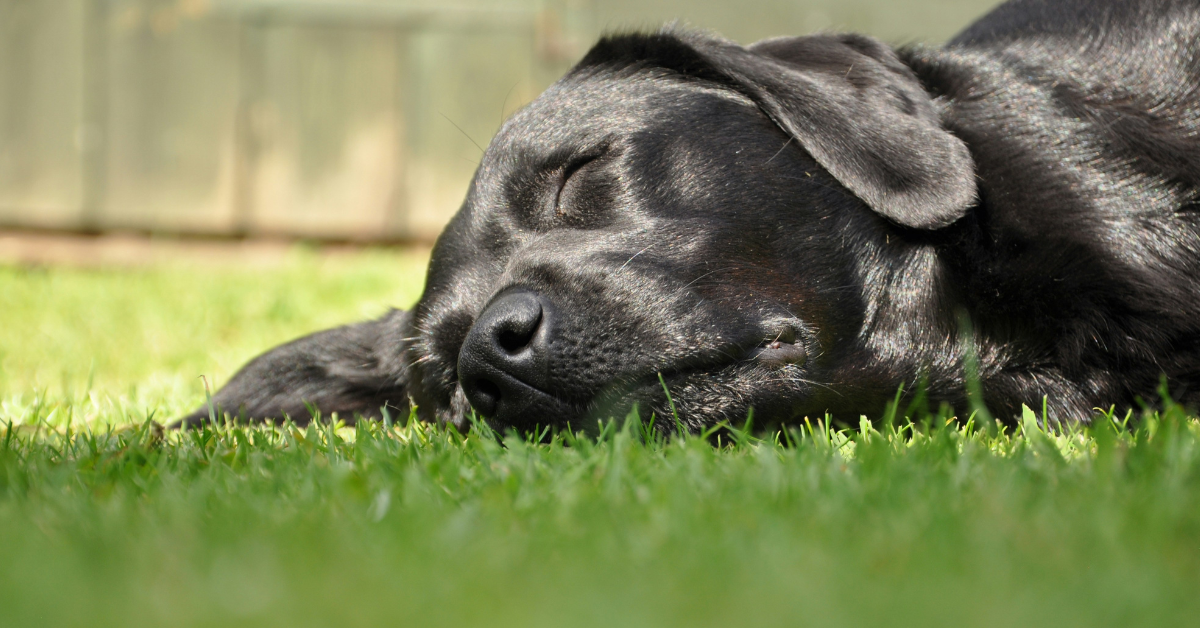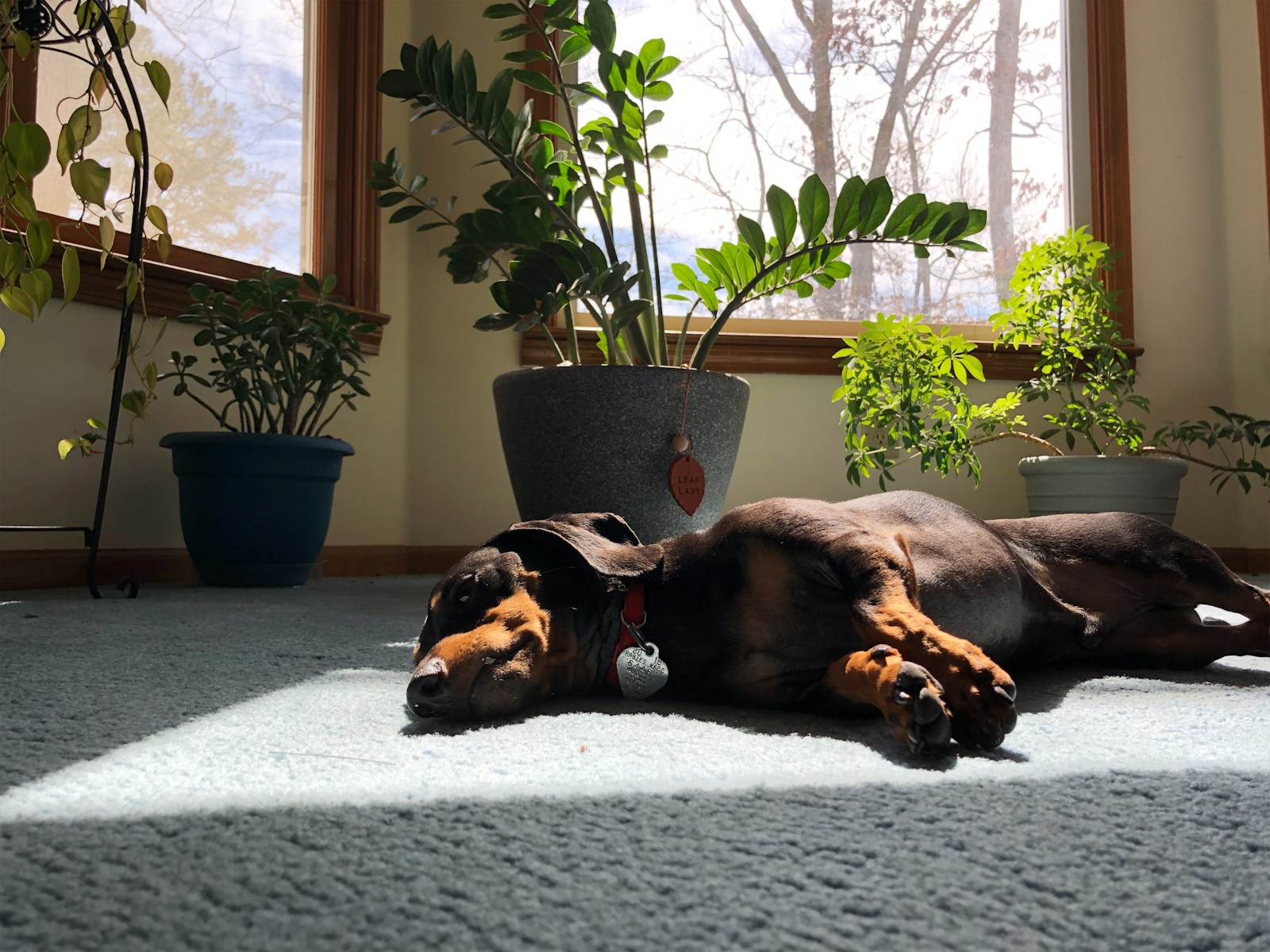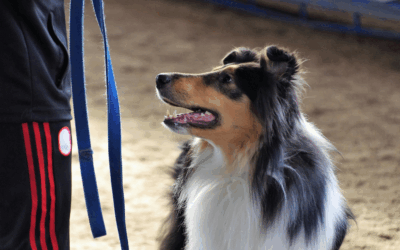I hear it all the time from well-meaning dog owners in Arlington, VA — “My dog’s so tired after the park!” or “He’s exhausted after daycare, so he must have had a great day.” But I always ask the same question in return: Is your dog tired, or is your dog balanced?
The phrase “dog tired” traditionally means completely exhausted, and for a long time, we’ve assumed that a tired dog is a good dog. We chase that post-play crash, believing it’s a sign of a happy, fulfilled companion. But after nearly two decades of working hands-on with Virginia’s dogs, I’ve learned that what we should be aiming for isn’t exhaustion at all. It’s calm fulfillment and balanced energy.
A dog that collapses into a heap after an hour of chaotic, overstimulating play isn’t necessarily happy. They might just be overwhelmed. At Canine Cardio, our goal has never been to simply wear dogs out. We’re here to help them live with structure, confidence, and balance—because a truly fulfilled dog isn’t just tired; they’re at peace.
Tired vs. Balanced: The Difference That Changes Everything
Many owners understandably confuse fatigue with fulfillment. It makes sense; a quiet dog who isn’t chewing the furniture or demanding attention seems like a win. But how they got to that quiet state matters immensely.
A Tired Dog Isn’t Always a Happy Dog
A tired dog might crash after the chaos of an off-leash park, where they were likely overstimulated by dozens of other dogs, unpredictable interactions, and a lack of structure. This type of exhaustion often comes with a side of anxiety, stress, and even newly learned bad habits. The dog isn’t resting peacefully; they’re recovering from a stressful event.
On the other hand, a balanced dog rests calmly after structured exercise and mental engagement. Their energy has been channeled purposefully, not just spent wildly. This is the core of the Canine Cardio philosophy: fitness with purpose. We believe that true wellness comes from intentional activity that engages both mind and body, building confidence along the way.
I remember one of my early clients, a high-energy Border Collie who was a regular at the local dog park. His owner proudly told me he would come home “dog tired” and sleep for hours. But he was also anxious, reactive on walks, and destructive when left alone. The chaos of the park was burning his energy but fueling his anxiety. We switched his routine to structured treadmill sessions and long walks, where he had to focus and follow leadership. The change was incredible. He still came home tired, but it was a different kind of tired. He was calm, relaxed, and his anxious behaviors melted away. He wasn’t just exhausted; he was content.
Is Your Dog Lethargic? When A Tired Dog Can Signal Something More Serious
While we often use “dog tired” casually, genuine and persistent exhaustion can be a red flag for your dog’s health. It’s crucial to distinguish between normal post-exercise tiredness and true and sudden lethargy, which can indicate an underlying medical issue.
Recognizing a Lethargic Dog vs. True Fatigue
Lethargy isn’t just sleepiness; it’s a noticeable lack of energy, motivation, or enthusiasm for things your dog usually enjoys. A dog that’s simply tired after a good workout will still greet you eagerly or get excited about dinner. A lethargic dog, however, may seem uninterested, unusually sluggish for no apparent reason.
Other Symptoms To Be On The Lookout For
Several underlying causes can lead to a lethargic dog:
- Illness or Infection: Conditions like kennel cough, heartworm disease, or even a simple bacterial infection can sap your dog’s energy.
- Injury or Pain: Hidden pain from an injury, arthritis, or other joint problems can make movement difficult and draining.
- Dehydration or Poor Nutrition: Not getting enough water or the right nutrients can quickly lead to fatigue.
- Emotional Stress: Significant changes in the home, anxiety, or depression can manifest as lethargy.
If you notice your dog’s tiredness is accompanied by other symptoms like a loss of appetite, vomiting, changes in bathroom habits, or sudden behavioral shifts, it’s time to call your veterinarian. Don’t dismiss persistent fatigue as just being “dog tired.”
The Healthy Kind of Tired: What Fulfillment Looks Like
So, what does the “good” kind of tired look like? It’s a state of calm contentment that follows purposeful activity. It’s the result of an engaged mind and a well-exercised body.
Purposeful Exercise Creates Calm, Not Chaos
When a dog’s exercise has structure, leadership, and a clear goal, it becomes a powerful outlet for their natural energy. It’s not just about running aimlessly; it’s about moving with intention. This is what we practice every day at the Canine Cardio Gym. Our programs are designed to do more than just burn calories—they build confidence and focus.
- Treadmill and Slatmill Training: This teaches dogs to maintain focus and a steady pace, building both physical endurance and mental discipline.
- Lure Work: This provides a safe and controlled outlet for a dog’s natural prey drive, offering intense physical conditioning.
- Swimming: Younger adult dogs might need extended, more intense periods of stimulation.A fantastic low-impact exercise that’s easy on the joints, perfect for dogs of all ages.
When I see a dog finish a session at our gym—with a loose body, soft eyes, and calm, even breathing—I know they’re not just exhausted. They’re deeply content. They’ve worked their body and their mind. This is exercise with intention, and it builds confidence, reduces reactivity, and strengthens the bond you share with your dog.
Senior Dogs and Tiredness: Aging Gracefully with Movement
As dogs get older, their energy levels naturally decrease. But that doesn’t mean their need for activity disappears. For senior dogs, movement is medicine. The key is to adapt their exercise to be safe, low-impact, and intentional.
Helping Older Dogs Stay Strong Without Overdoing It
A common mistake owners of senior dogs make is assuming their tired dog should stop moving altogether. In reality, structured, gentle activity is crucial for maintaining mobility, muscle mass, and mental sharpness. Inactivity can lead to stiffness, weight gain, and a faster decline in overall health.
Low-impact exercises like swimming or controlled walks on a treadmill are perfect for older dogs. These activities help keep their joints lubricated and their minds engaged without putting undue stress on their aging bodies. At Canine Cardio, our recovery and rehabilitation programs are specifically designed for senior dogs or those recovering from injury or surgery, ensuring they get the movement they need in a safe, supervised environment.
Remember, age doesn’t mean a sedentary life. It just means shifting from high-impact play to intentional, supportive activity.
How to Tell When to Worry About Fatigue
It’s normal for your dog to be tired after a long day of fun. But when does “just tired” become a cause for concern? Here’s a quick checklist of warning signs and other signs that indicate your dog’s fatigue might not be normal.
When “Just Tired” Isn’t Normal | Seek Veterinary Attention
Contact your veterinarian if you notice any of the following:
- Sudden or Extreme Lethargy: Your dog is unusually tired or sluggish and it lasts for more than 24-48 hours.
- Refusal to Engage: They show no interest in normal activities they love, like walks, playing, or even getting a treat.
- Loss of Appetite or Vomiting: Fatigue accompanied by gastrointestinal issues is a definite red flag.
- Labored Breathing or Coughing: Difficulty breathing while resting is never a normal sign of being tired.
- Unusual Disinterest: They seem withdrawn and don’t want to interact with you or other family members.
Trust your instincts. You know your dog better than anyone. While some rest and recovery are perfectly healthy, true well-being comes from balance, not burnout. If something feels off, it’s always best to get it checked out.

Photo by konrad dobosz on Unsplash
Building a Balanced Life for Your Dog
Shifting your mindset from tiring your dog out to fulfilling them is a game-changer. It’s about creating a lifestyle that nurtures calm confidence over chaotic energy.
From Overstimulated to Centered—The Canine Cardio Way
The journey from an overstimulated, anxious dog to a calm, centered companion begins with structure. Instead of unstructured free-for-alls, focus on activities that require your dog to think, focus, and follow your lead. This could be a structured walk, a training session, or a purposeful fitness activity.
At Canine Cardio, this philosophy is at the heart of everything we do. Our gym, structured daycare, and training programs are all designed to help dogs move with purpose, recover with guidance, and grow through structure. Even our on-leash community café, Snouts & Stouts, provides a calm environment where dogs and their humans can unwind and connect without the chaos.
Tired Isn’t the Goal—Fulfilled Is
After nearly two decades of working hands-on with Virginia’s dogs, I’ve learned that the happiest dogs aren’t the ones who crash from exhaustion. They’re the ones who rest peacefully after a day filled with structure, purpose, and leadership. They are the dogs who have had their physical, mental, and emotional needs met in a balanced way.
I encourage you to rethink what your dog truly needs. Is it more chaos, or more calm? More running, or more guidance? Strive for a life of balanced energy and consistent leadership, and you’ll find that a fulfilled dog is the greatest reward of all.
Helpful Resources for Understanding Dog Tiredness and Balance
- American Kennel Club (AKC) – Tips for a Happy, Healthy Dog
The AKC provides valuable insights on ways to ensure your dog stays healthy and balanced, including exercise recommendations.
Visit the AKC website - ASPCA – Pet Care Guides
Explore comprehensive dog care tips from the ASPCA, including activity requirements and mental stimulation advice.
Explore ASPCA resources - The Spruce Pets – How Much Exercise Does Your Dog Need?
This resource breaks down exercise requirements tailored to different breeds, helping you cater to your dog’s specific needs.
Read on The Spruce Pets - VCA Animal Hospitals – The Importance of Mental Stimulation
Learn from experts why mental enrichment is just as important as physical exercise for your dog’s overall well-being.
Visit VCA Animal Hospitals - PetMD – Activity and Exercise for Dogs
PetMD offers a variety of articles addressing activity levels, behavioral health, and tips to avoid over-exhaustion.
Check out PetMD - Whole Dog Journal – Balancing Physical and Mental Exercise
This resource explores creative ways to balance physical and mental stimulation through training and play.
Read Whole Dog Journal - DogTime – Top 10 Dog Enrichment Activities
DogTime provides practical and fun ideas to keep your dog both physically and mentally fit.
Visit DogTime

Ready to Help Your Dog Find Balance?
If your pup’s energy feels chaotic—or if they’re ‘dog tired’ for all the wrong reasons—let’s start their wellness journey together. The path to a calmer, more confident dog begins with structure and purpose.
Contact us today to schedule an evaluation or tour the Canine Cardio Gym in Arlington, VA. Let’s work together to bring peace, balance, and fulfillment back into your dog’s life.






